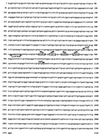Molecular characterization of chromosomal class C beta-lactamase and its regulatory gene in Ochrobactrum anthropi
- PMID: 11451692
- PMCID: PMC90649
- DOI: 10.1128/AAC.45.8.2324-2330.2001
Molecular characterization of chromosomal class C beta-lactamase and its regulatory gene in Ochrobactrum anthropi
Abstract
Ochrobactrum anthropi, formerly known as CDC group Vd, is an oxidase-producing, gram-negative, obligately aerobic, non-lactose-fermenting bacillus of low virulence that occasionally causes human infections. It is highly resistant to all beta-lactams except imipenem. A clinical isolate, SLO74, and six reference strains were tested. MICs of penicillins, aztreonam, and most cephalosporins tested, including cefotaxime and ceftazidime, were >128 microg/ml and of cefepime were 64 to >128 microg/ml. Clavulanic acid was ineffective and tazobactam had a weak effect in association with piperacillin. Two genes, ampR and ampC, were cloned by inserting restriction fragments of genomic DNA from the clinical strain O. anthropi SLO74 into pBK-CMV to give the recombinant plasmid pBK-OA1. The pattern of resistance to beta-lactams of this clone was similar to that of the parental strain, except for its resistance to cefepime (MIC, 0.5 ,micro/ml). The deduced amino acid sequence of the AmpC beta-lactamase (pI, 8.9) was only 41 to 52% identical to the sequence of other chromosomally encoded and plasmid-encoded class C beta-lactamases. The kinetic properties of this beta-lactamase were typical for this class of beta-lactamases. Upstream from the ampC gene, the ampR gene encodes a protein with a sequence that is 46 to 62% identical to those of other AmpR proteins and with an amino-terminal DNA-binding domain typical of transcriptional activators of the Lys-R family. The deduced amino acid sequences of the ampC genes of the six reference strains were 96 to 99% identical to the sequence of the clinical strain. The beta-lactamase characterized from strain SLO74 was named OCH-1 (gene, bla(OCH-I)).
Figures






Similar articles
-
Cloning and characterization of a chromosomal class C beta-lactamase and its regulatory gene in Laribacter hongkongensis.Antimicrob Agents Chemother. 2005 May;49(5):1957-64. doi: 10.1128/AAC.49.5.1957-1964.2005. Antimicrob Agents Chemother. 2005. PMID: 15855519 Free PMC article.
-
Characterization, cloning and sequence analysis of the inducible Ochrobactrum anthropi AmpC beta-lactamase.J Antimicrob Chemother. 2001 Jun;47(6):745-54. doi: 10.1093/jac/47.6.745. J Antimicrob Chemother. 2001. PMID: 11389106
-
Biochemical and molecular characterization of three new variants of AmpC beta-lactamases from Morganella morganii.Antimicrob Agents Chemother. 2006 Mar;50(3):962-7. doi: 10.1128/AAC.50.3.962-967.2006. Antimicrob Agents Chemother. 2006. PMID: 16495258 Free PMC article.
-
[Progress in regulatory mechanism for inducing β-lactamase in Gram-negative bacteria].Sheng Wu Gong Cheng Xue Bao. 2018 Aug 25;34(8):1288-1296. doi: 10.13345/j.cjb.180187. Sheng Wu Gong Cheng Xue Bao. 2018. PMID: 30152214 Review. Chinese.
-
Genetic basis of induction and overproduction of chromosomal class I beta-lactamase in nonfastidious gram-negative bacilli.Rev Infect Dis. 1988 Jul-Aug;10(4):782-5. doi: 10.1093/clinids/10.4.782. Rev Infect Dis. 1988. PMID: 3055175 Review.
Cited by
-
Ochrobactrum anthropi infection following corneal transplantation -a case report and review of literature.BMC Ophthalmol. 2024 Jun 3;24(1):234. doi: 10.1186/s12886-024-03472-z. BMC Ophthalmol. 2024. PMID: 38831303 Free PMC article. Review.
-
Multilocus sequence typing supports the hypothesis that Ochrobactrum anthropi displays a human-associated subpopulation.BMC Microbiol. 2009 Dec 18;9:267. doi: 10.1186/1471-2180-9-267. BMC Microbiol. 2009. PMID: 20021660 Free PMC article.
-
Molecular and biochemical characterization of a novel class A beta-lactamase (HER-1) from Escherichia hermannii.Antimicrob Agents Chemother. 2003 Aug;47(8):2669-73. doi: 10.1128/AAC.47.8.2669-2673.2003. Antimicrob Agents Chemother. 2003. PMID: 12878539 Free PMC article.
-
Beta-lactam antibiotics: from antibiosis to resistance and bacteriology.APMIS. 2010 Jan;118(1):1-36. doi: 10.1111/j.1600-0463.2009.02563.x. APMIS. 2010. PMID: 20041868 Free PMC article. Review.
-
Cloning and characterization of a chromosomal class C beta-lactamase and its regulatory gene in Laribacter hongkongensis.Antimicrob Agents Chemother. 2005 May;49(5):1957-64. doi: 10.1128/AAC.49.5.1957-1964.2005. Antimicrob Agents Chemother. 2005. PMID: 15855519 Free PMC article.
References
-
- Bizet C, Bizet J. Sensibilité comparée de Ochrobactrum anthropi, Agrobacterium tumefaciens, Alcaligenes faecalis, Alcaligenes denitrificans subsp. denitrificans, Alcaligenes denitrificans subsp. xylosoxydans et Bordetella bronchiseptica vis-à-vis de 35 antibiotiques dont 17 β-lactamamines. Path Biol. 1995;43:258–263. - PubMed
-
- Brivet F, Guibert M, Kiredjian M, Dormont J. Necrotizing fasciitis, bacteremia, and multiorgan failure caused by Ochrobactrum anthropi. Clin Infect Dis. 1993;17:516–518. - PubMed
Publication types
MeSH terms
Substances
LinkOut - more resources
Full Text Sources
Research Materials
Miscellaneous

